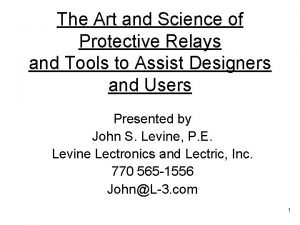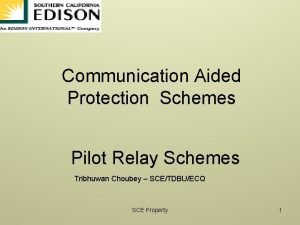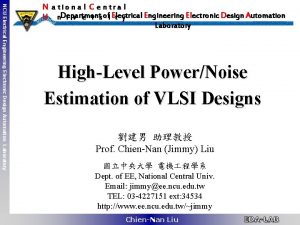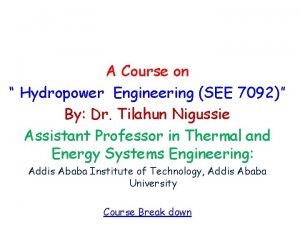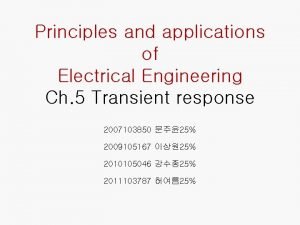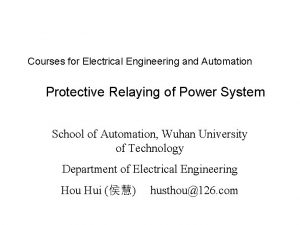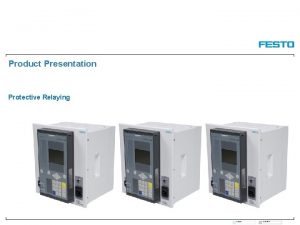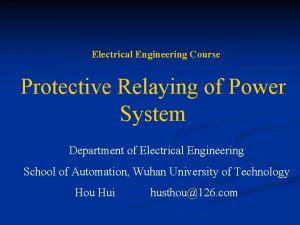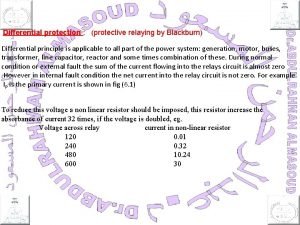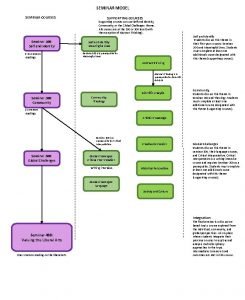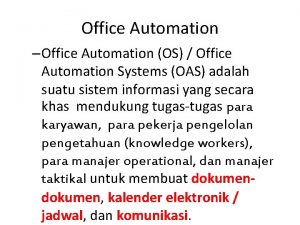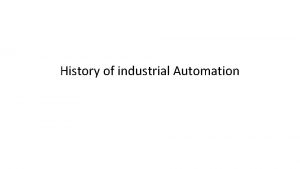Electrical engineering and automation courses Protective Relaying of












- Slides: 12

Electrical engineering and automation courses Protective Relaying of Power System Wuhan University of Technology School of Automation Department of Electrical Engineering Hou Hui husthou@126. com

Chapter 15 Busbar Protection § 15. 1 Basic principle of busbar fault and busbar protection § 15. 2 Basic principle of busbar differential protection § 15. 3 Special problems and countermeasures of busbar protection § 15. 4 Brief introduction to breaker failure protection

§ 15. 1 Basic principle of busbar fault and busbar protection Power plants and substations is an important component of the power system. Busbar fault will make all the elements are connected to the bus fault during repair bus, or converted to another set of fault free bus before forced outage. In addition, in the power system, the fault of the busbar of the substation will cause damage to the system stability and cause serious consequences. The short circuit faults occurring on the bus may be faults of various types of earthing and interphase faults. The type of bus short circuit fault is different from that of transmission line. In the short-circuit fault of power transmission line, the single-phase earth fault accounts for more than 80% of the total number of faults. In the bus fault, most of the failure was caused by the discharge of insulators caused by the bus fault beginning mostly for single-phase ground fault, and with mobile short circuiting arc, faults often developed into two-phase or three-phase short circuit.

In general, the busbar fault can be removed without the use of special busbar protection and the protection device of the power supply element. (1)The power plant shown in Figure 15 -1 uses a single bus connection, If there is no power supply to the bus line to the opposite side, the fault on the bus can be used to trip the generator circuit breaker by overcurrent protection of the generator; (2)As shown in Figure 15 -2, the normal bus run separately from the low pressure side, if connected to the low voltage side of bus line for the feeder line, then the fault on the low voltage bus can by overcurrent protection corresponding transformer tripping of the circuit breaker to be removed; Figure 15 -1 Using overcurrent protection of Figure 15 -2 Using overcurrent protection of generator to remove bus fault transformer to remove bus fault

(3)As shown in Fig. 15 -3, the bilateral power network (or loop network) can be removed by the protection of 1 and 4 of the II segment when the d point on the substation B bus is shorted. A 1 4 2 d 3 B As shown in Figure 15 -3 , the power side protection is used to remove the bus fault on the bilateral power network. The fault removal time is usually longer when the busbar fault is removed by the protective device of the power supply element. In addition, when the two buses are running simultaneously or the bus is a single bus segment, the above protection can not guarantee the selective removal of the fault bus. Bus in EHV hub substation and large power plant associated with each area system and the large generating units, so the bus shortcircuit directly undermines the synchronous operation between each part of the system or the unit, and impact on the safety of power supply in power system as well. Although the probability of short circuit bus is lower than that of transmission line, but once it happens, the result is especially serious. So for those who threaten stability of power system operation, the power plant and electric power supply voltage below the allowable value of the important load (usually 60% rated voltage) of the bus fault, must be equipped with fast busbar protection selectivity.

Therefore, special bus protection shall be installed in the following circumstances : (1)On the 110 k. V and above double bus and sectional single bus, special bus protection shall be installed to ensure that the faults in any group (or section) buses are selectively removed, while another (or segment) fault free bus can continue to operate. (2)In the 110 k. V and above single busbar, 35 k. V bus of important power plant and the 35 k. V bus of the important stepdown substation at the high voltage side is 110 k. V and above, special bus protection shall be installed in order to quickly remove the fault on the bus according to the requirements of the installation of the speed protection of the whole line.

§ 15. 2 Basic principle of busbar differential protection In order to meet the requirements of speed and selectivity, busbar protection is made up of differential principle. The characteristic of busbar differential protection is that the bus is usually connected with more electrical elements (such as line, transformer, generator, etc. ). Therefore, it can not be realized only by simple wiring as the differential protection of generator. But no matter how many components are on the bus, the basic principle of realizing differential protection is applicable. 1) In normal operation and faults occur outside the bus range, the current flowing in and out of the current is equal to or equal to the current in all connected components of the bus. 2) When busbar fault occurs, all the components are connected with the power supply bus from fault point load current supply short-circuit current or outflow residues, and in the power supply connecting element to load current is equal to zero, therefore, according to Kirchhoff's current law:

3)As from the phase of the current in each of the connecting elements, the current phase in at least one component and the current phase in the other element are reversed in normal operation as well as external failure, Specifically, the current flowing into the element and the current flowing out of the element, the opposite of the opposite. When the bus is out of order, the current in the other components is close to the same phase except that the current is equal to zero. According to the principle (1) and the principle (2), the current differential protection can be formed. While the current differential protection can be formed according to the principle (3).

Bus differential protection type 13. 2. 1 Single bus full current differential bus protection 13. 2. 2 High impedance busbar differential protection 13. 2. 3 Medium impedance busbar differential protection with ratio braking characteristic 13. 2. 4 current ratio phase bus protection 13. 2. 5 Busbar differential protection with double bus fixed connection 13. 2. 6 busbar current differential bus differential protection

§ 13. 4 Brief Introduction to Circuit Breaker Failure Protection When the transmission line, transformer or bus is short circuited in power plants and substations at voltages above 110 k. V and above, the protection device acts on the removal of the fault, the circuit breaker of the fault element may be refused to move, and the fault of the breaker occurs. There are many reasons for the malfunction of circuit breaker, such as breaker tripping, coil disconnection, breaker operation failure and so on. Circuit breakers and protective devices in high voltage power grids shall have a backup role to allow for the effective removal of faults when the circuit breaker or protective device fails. The remote backup protection scheme of the adjacent component is the simplest and reasonable backup mode, which is not only the backup of protection and rejection, but also the backup of the circuit breaker's refusal to move. But in the high voltage power system, the reserve mode often have greater difficulty (not enough sensitivity) because the power supply branch increase. Meanwhile the long operation time easy to cause the expansion of the scope of the accident, even cause system instability and collapse of the whole network. In view of this, the central region and the 220 k. V grid above the trunk line, the system stability requirements must be installed across the speed protection, usually installed two sets of independent fast protection main protection (i. e. dual protection), to refuse to move protection device; For circuit breakers, breaker failure protection is specially installed.

1. Conditions for setting up circuit breaker failure protection Because the circuit breaker fails to protect, the protection is in case of system failure and circuit breaker failure, so it is appropriate to reduce its requirement, that is, only the final fault can be removed. Conditions for setting up circuit breaker failure protection: (1)When the remote backup protection sensitivity of the adjacent elements is not enough, the circuit breaker failure protection shall be installed. A circuit breaker for phase splitting operation permits to verify the sensitivity only by single phase to ground faults. (2)According to the importance of the transformer substation and the size of the installation failure protection, the circuit breaker failure protection is decided. For example, 220 k. V and above substations with multi bus operation should be equipped with fail protection when failure protection can reduce the power failure range caused by circuit breaker rejection.

2. Requirements for circuit breaker failure protection (1) The malfunction of malfunction protection is the same as the misoperation of busbar protection, which has a wide range of influence and must have higher reliability. (2) The failure protection is first performed on the mother circuit breaker and the sectional circuit breaker, and thereafter the adjacent element protection can be removed by successive actions, and the failure protection only acts on the mother circuit breaker and the sectional breaker. (3) On the premise of ensuring no misoperation, the circuit breaker shall be removed with a shorter delay and selectivity. (4) Fault identification unit and tripping latch element for fault protection shall be sensitive enough to the terminal fault of circuit breaker or equipment.
 The art and science of protective relaying
The art and science of protective relaying Pilot relaying schemes
Pilot relaying schemes Electrical design automation
Electrical design automation Lisa gommer
Lisa gommer Fnu engineering courses
Fnu engineering courses Hydropower engineering courses
Hydropower engineering courses Pipeline engineering courses online
Pipeline engineering courses online Klipsch school of electrical and computer engineering
Klipsch school of electrical and computer engineering What is estimation in electrical engineering
What is estimation in electrical engineering Ts-2di
Ts-2di Tum department of electrical and computer engineering
Tum department of electrical and computer engineering Principles and applications of electrical engineering
Principles and applications of electrical engineering Pearson engineering
Pearson engineering
